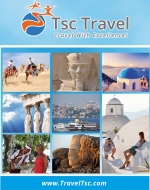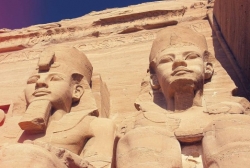FIND YOUR EGYPT TRIP
Find best priced trips in Egypt..
EGYPT TRAVEL GUIDE
ABOUT EGYPT
Egypt has a strategic location in North Africa close to the Middle East. The country borders Libya to the west, Sudan to the south, Israel and The Gaza Strip to the east via the Sinai Peninsula and a land bridge that crosses the Suez Canal. Its North cost is lapped by the Mediterranean while its lower east coast and sounth Sinai lie alongside the Red Sea.
The country has long played an important role in connecting Africa with Asia and the Mediterranean with the Indian Ocean.
Egypt has four distinct areas. The Nile Delta itself is a stretch of land that fans out north from a point close to Cairo where the Nile splits into smaller flows of water, reaching a stretch of coastline that runs from Alexandria to Port Said. At the coast the waters of the Nile flow into the Mediterranean. Along the coastline are the towns and cities of El Alamein , famed for its Second World War battles and museums, along with Marsa Matruh and Sallum to the west of Alexandria, while to its east is the historic Rosetta, where the Rosatta Stone an important artefact that was key to deciphering ancient Egyptian hieroglyphic writing, was discovered. Further along the coast is Damietta and Port Said.
The Nile Valley stretches from the delta to Egypt’s southernmost border with Sudan, and along with its great cities are homes to some of the world’s most iconic symbols of ancient civilizations. Here visitors can see the three Great Pyramids of Giza and the Sphinx that guards them, the fabuluos Luxor Temple and the Karnak Temple in Luxor, the Valley of the Kings and of course , the Nile River itself. The Sahara Desert, the world’s second largest , makes up much of Egypt’s distinct desert and oasis areas, which are fascinating if sparsely inhabited, while the Sinai Peninsula and the Red Sea coastline and resorts are the country’s top spots for family fun and water sport themed holidays.
Egypt has four distinct areas. The Nile Delta itself is a stretch of land that fans out north from a point close to Cairo where the Nile splits into smaller flows of water, reaching a stretch of coastline that runs from Alexandria to Port Said. At the coast the waters of the Nile flow into the Mediterranean. Along the coastline are the towns and cities of El Alamein , famed for its Second World War battles and museums, along with Marsa Matruh and Sallum to the west of Alexandria, while to its east is the historic Rosetta, where the Rosatta Stone an important artefact that was key to deciphering ancient Egyptian hieroglyphic writing, was discovered. Further along the coast is Damietta and Port Said.
The Nile Valley stretches from the delta to Egypt’s southernmost border with Sudan, and along with its great cities are homes to some of the world’s most iconic symbols of ancient civilizations. Here visitors can see the three Great Pyramids of Giza and the Sphinx that guards them, the fabuluos Luxor Temple and the Karnak Temple in Luxor, the Valley of the Kings and of course , the Nile River itself. The Sahara Desert, the world’s second largest , makes up much of Egypt’s distinct desert and oasis areas, which are fascinating if sparsely inhabited, while the Sinai Peninsula and the Red Sea coastline and resorts are the country’s top spots for family fun and water sport themed holidays.
History
The History of Egypt stretches back to unimaginable times. It’s a country best known to the world with its pharoahs such as Tutankhamun and its ancient civilizations that largely existed along the banks of the Nile River and created so many of its iconic structures.
The earliest signs of civilization have beed dated to prehistoric times, although the towns and cities of today can probably trace their roots back to around 8000 BC when the Sahara was formed and settlers started moving closer to the fertile land of the Nile River banks and eventually created communities. These ancient civilizations developed and grew entirely because of the Nile during a period known as the predynastic , a time before the pharoahs ruled the country.
The dynastic period, widely regarded as one of the oldest ever cultural periods in the world and so called because it was a series of dynasties that ruled the country, began in around 3100 BC. The first pharoahs is generally believed to have been Menes, who was instrumental in joining and then divided Egypt into two. The country was known as tawy, meaning ‘two lands’
A total of 30 dynasties ruled over the next tree millennia until around the year 30 BC. Many, if not all of the pharoahs, wanted to put their own mark on Egypt and had supremely beautiful palaces, temples, tombs and structures built. It was during this time that most of the astonishing sights that can still be seen today were constructed, among them the Pyramids of Giza and the Sphinx of the Old Kingdom, and the Temples of Luxor in the New Kingdom.
Egypt has seen many periods of history since the ancient dynastic era and has reminders of how it flourished under different civilizations.
The earliest signs of civilization have beed dated to prehistoric times, although the towns and cities of today can probably trace their roots back to around 8000 BC when the Sahara was formed and settlers started moving closer to the fertile land of the Nile River banks and eventually created communities. These ancient civilizations developed and grew entirely because of the Nile during a period known as the predynastic , a time before the pharoahs ruled the country.
The dynastic period, widely regarded as one of the oldest ever cultural periods in the world and so called because it was a series of dynasties that ruled the country, began in around 3100 BC. The first pharoahs is generally believed to have been Menes, who was instrumental in joining and then divided Egypt into two. The country was known as tawy, meaning ‘two lands’
A total of 30 dynasties ruled over the next tree millennia until around the year 30 BC. Many, if not all of the pharoahs, wanted to put their own mark on Egypt and had supremely beautiful palaces, temples, tombs and structures built. It was during this time that most of the astonishing sights that can still be seen today were constructed, among them the Pyramids of Giza and the Sphinx of the Old Kingdom, and the Temples of Luxor in the New Kingdom.
Egypt has seen many periods of history since the ancient dynastic era and has reminders of how it flourished under different civilizations.
It has been occupied by the Persians, Romans, Greeks, Arabs , Otoman Turks, British and French but it’s probably the pharoahs that have left the most fascinating legacy on the country and one which makes tourism one of the country’s leading industry today.
Who can not be captivated by the story of Tutankhamun, the young boy who became king in 1333 BC, becoming the Pharoah of the 18th dynasty, and whose solid gold death mask is probably the most famous artefact ever found in Egypt. The beautiful Nefertiti, the wife of the Egyptian Pharoah Akhenaton, who might have ruled in her own right bfore Tutankhamun became a king. These are the most interesting characters make people wonder about Egypt.
Climate
The weather in Nile Valley region can differ quite considerably from Alexandria on the cost in the north, along the river to Luxor, Aswan or Abu Simbel further south.
The climate in the Nile Valley is moderate with lots of sunshine and very few rainy days, unlike the desert areas that have much hotter temperatures. The best times to visit are from Mid April onwards May or September and October, November when thebtemperatures are lower therefore making it easier to sightsee and explore. Between the months of July and August the sun is at its hottest. Avarage temperatures in Cairo are around 25-35 centigrade (95 F), while in Luxor they are 30-40 centigrade (107 F) and in Aswan hotter still at 31-42 centigrade.


